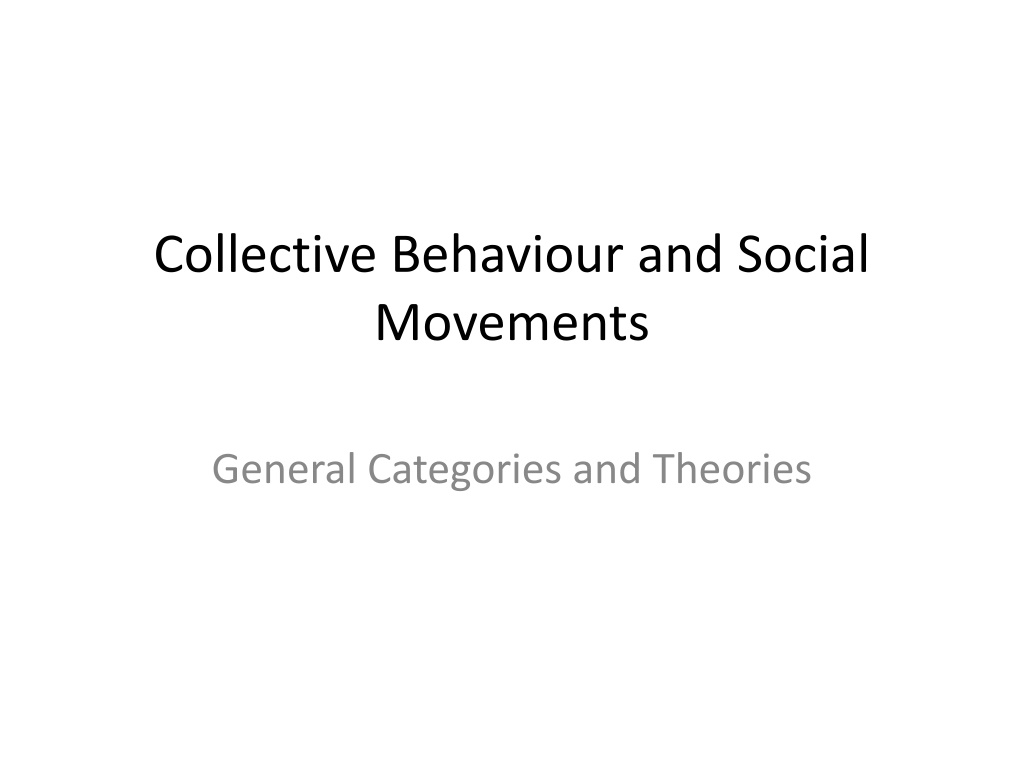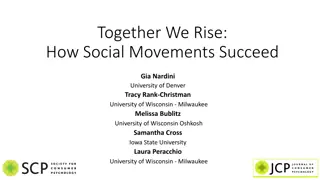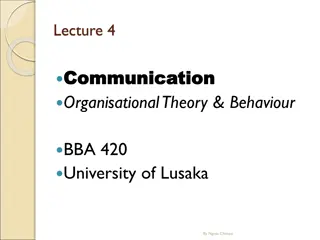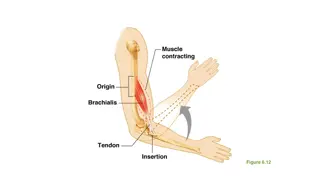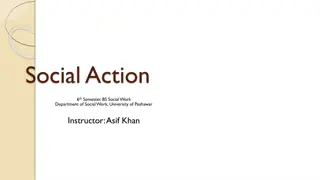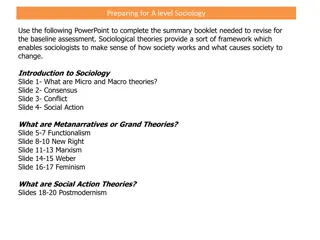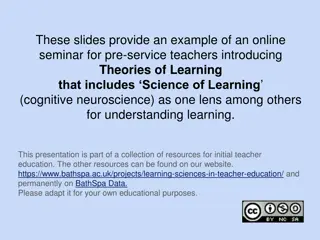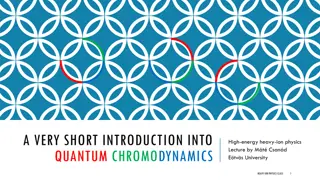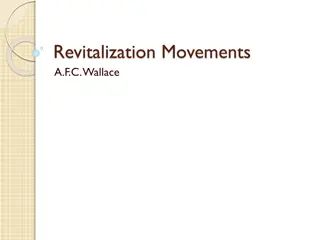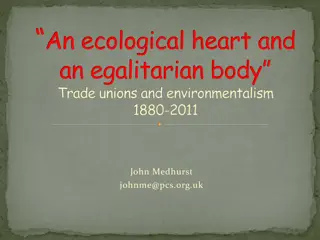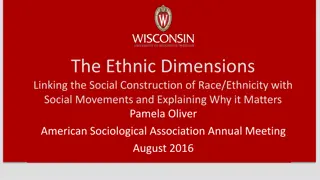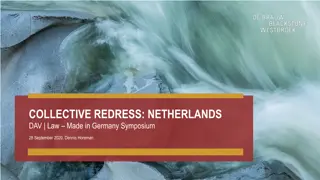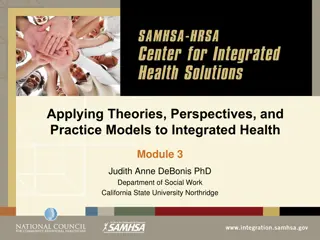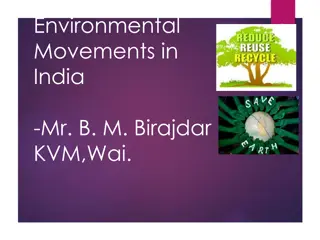Understanding Collective Behaviour and Social Movements: Theories and Examples
Collective behaviour involves voluntary and often spontaneous actions by a large group of people that defy societal norms, with examples ranging from panics and mobs to celebrations and riots. Conditions such as timing, social control breakdown, and structural strains can trigger collective behaviour. The dynamics of collective behaviour include the presence of immediate communication, the strength in numbers, and the role of leaders. Different types of crowd behaviour include expressive, casual, and protest crowds, with variations in intensity and purpose.
Download Presentation

Please find below an Image/Link to download the presentation.
The content on the website is provided AS IS for your information and personal use only. It may not be sold, licensed, or shared on other websites without obtaining consent from the author. Download presentation by click this link. If you encounter any issues during the download, it is possible that the publisher has removed the file from their server.
E N D
Presentation Transcript
Collective Behaviour and Social Movements General Categories and Theories
Buddhist monk protest South Vietnamese governments prohibition of Buddhists religious practices 1963
Collective Behaviour Defined: Voluntary, often spontaneous activity that is engaged in by a large number of people and typically violates dominant group norms and values Often contrasted to organizational behaviour Examples: panics, crowds, fashion, fads, mobs, celebrations, riots
Conditions for Collective Behaviour Collectivity: a relatively large number of people who mutually transcend, bypass, or subvert established institutional patterns and structures Conditions: Timing Breakdown in social control mechanism Structural strains and factors that increase likelihood of a type of response, such as the existence of inequalities
Conditions for Collective Behaviour Collectivity: a relatively large number of people who mutually transcend, bypass, or subvert established institutional patterns and structures Conditions: Timing Breakdown in social control mechanism Structural factors that increase likelihood of a type of response
Dynamics of Collective Behaviour Acting outside of established norms Presence of immediate communication Why collectively and not individually? Strength in numbers Presence of leaders Theorists differ in whether collective behavoiur is seen as representing rational or irrational behaviour
Types of Crowd Behaviour Expressive and Acting Crowds Casual and Conventional Protest Expressive: Come together to express a strong emotions Not violent; may take the form of civil disobedience (Martin Luther King Jr) Causal: large; happen to be in one place at one time Acting: intense and violent Mob: a highly emotional crowd whose members are violent and organized against a person, group or places Conventional: those who come together for a scheduled event Riot: Violent crowds with no apparent target Panic: Mass reactions to a real or perceived threat
Theories of Crowd Behaviour Contagion Theory Social unrest and circular reaction Convergence Theory Emergent Norm Theory
Contagion Theory Gustave Le Bon (1841-1931) People feel vulnerable and, with anonymity, the crowd transforms people from being rational to being irrational and a common mind is created One will do things in a crowd that one would never deem appropriate to do on their own The lowest common denominator rules.
Convergence theory Crowd behavior reflects the beliefs and intentions that individuals already share before they join a crowd. People bring shared emotions, goals, and beliefs to crowd behaviour. These shared elements bring people together. This theory might be applied to lynch mobs and environmental protests
Emergent Norm Theory People are not sure how to behave when they begin to interact in collective behavior. As they discuss their potential behavior, norms governing their behavior emerge, and social order and rationality then guide their behavior. The vitality of social norms is central in shaping crowd behaviour Crowdbehaviour is not purely random and irrational Example: the Los Angeles riots of 1992 purposively targeted Korean businesses Meaning and norms are redefined by the crowd. Ralph Turner and Lewis Killian (1957)
Mass Behaviour Defined: Collective behaviour that takes place when people respond to the same event in much the same way (e.g., a rock concert) even though they may be geographically separated. Types: Rumour Gossip Mass hysteria Public opinion Fashions Fads Propaganda
Mass Behaviour Fashions Currently valued style of behaviour, thinking or appearance Fads Temporary but widely copied activity enthusiastically followed by large numbers of people. Short term. Pierre Bourdieu believes fashion is one-way individuals can express their class differences
Crowds and Power (1984) Nobel Peace Prize Open crowds Closed crowds Seek growth No boundaries Desire new members Dissipate when the collecting issue is absent Limits on membership Seek permanence Have requirements for membership
Social Movements Defined: an organized group that acts consciously to promote or resist change through collective action Elements: More likely in democracies Help excluded groups have a voice in political processes Rely on volunteers
Types of Social Movements Reform Revolutionary Religious Alternative Resistance
ReformMovements Movements that seek to improve society Work within existing structures Work to change public policy Examples: labour movements, animal rights MADD Mothers Against Drunk Driving http://www.madd.org/activism/
Revolutionary Movements Hope to bring about a total change in societal organization and power structure French(1789), American (1779), or Russian Revolutions (1917) Terrorism calculated unlawful use of physical force or threats of violence against persons or property to intimidate or coerce a government, organization, or individual for the purpose of gaining some political, religious, economic or social objective
Religious Movements Inner change focus Liberation Theology: stresses the role of political action and worked toward the goal of political liberation from poverty and oppression. The Social Gospel movement was a prominent Protestant movement in the late 19th-20th century that attempted to apply Christian principles to social problems. The Salvation Army is an example.
Alternative Movements To seek limited change in some aspects of people s lives or behaviours Example: The Women s Christian Temperance Union to prevent the use of alcohol, which was also a drive to keep men at home and supporting their families Veganism and organic food movements Participaction
Resistance Movements Seek to prevent change Example: the Pro Life Movement Anti-immigration movements
Stages in Social Movements Preliminary stage - wide spread unrest, becoming aware of a problem Coalescence stage getting organized to publicize a problem Institutionalization stage organizational structure develops.
New Social Movement Theme: scholars look at a diverse array of collective actions and the manner in which these actions are based on politics, ideology, and culture Elements: Personal identity, race, class, gender and sexuality Examples-gender pronoun use movements, trans- sexuality movement
New Social Movement Ecofeminism- feminists that are concerns with the environment and believe that environmental neglect and abuse is implicit in the patriarchal capitalist business model. Environmental racism the belief that a disproportionate number of hazardous facilities are placed in low-income areas populated primarily by people of colour
Questions What factors can influence crowd behaviour? How can crowd behaviour be interpreted as incipient expressions of desires for social change? What does Smelser s structural strain explain about collective behaviour?
